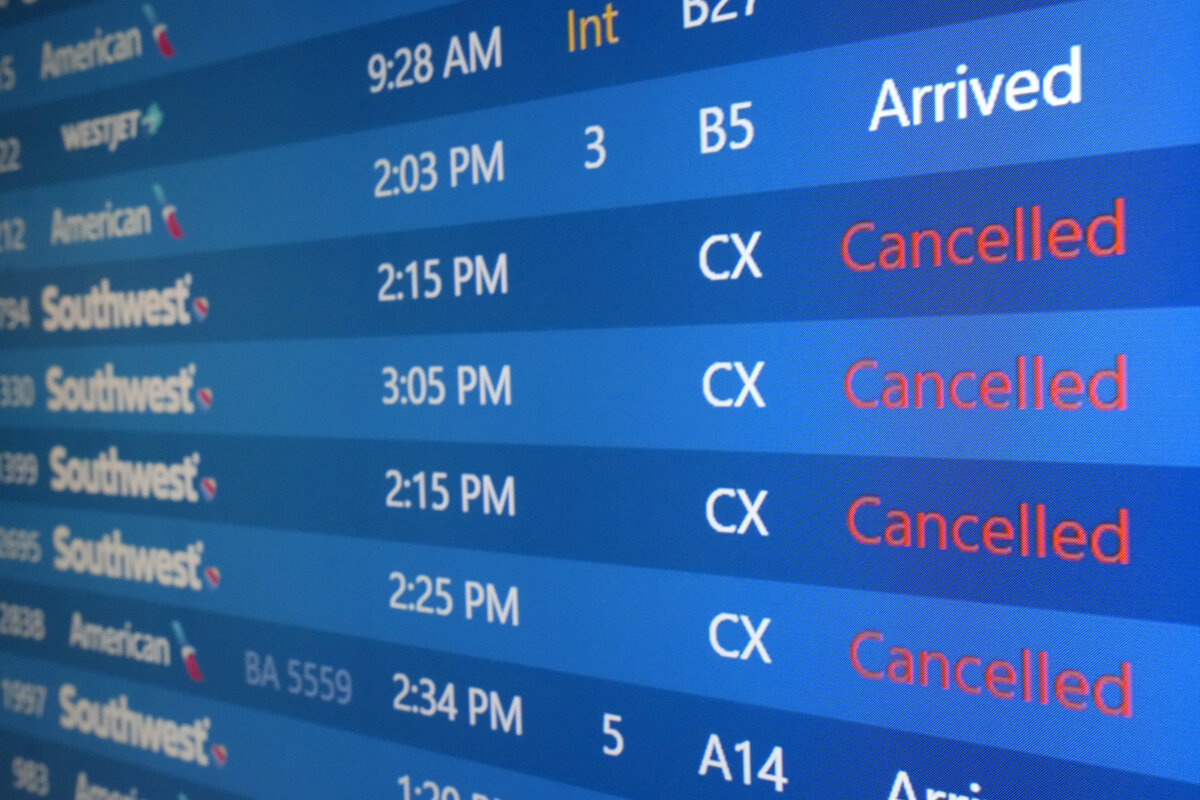Airlines Cancel Flights Amid Severe Weather is a headline that resonates all too frequently as unpredictable weather wreaks havoc on travel plans. From blizzards to hurricanes, severe weather poses significant challenges for airlines, leading to widespread flight cancellations that affect countless passengers. Understanding the reasons behind these cancellations and how airlines manage them can help travelers navigate their journeys more smoothly.
Severe weather events, such as thunderstorms, snowstorms, and high winds, disrupt flight operations by creating unsafe conditions for takeoff and landing. Airlines face operational hurdles during such events, including rerouting flights and ensuring passenger safety. Additionally, the economic impact of these cancellations extends beyond the airlines, affecting travelers who may incur added costs and inconveniences.
Impact of Severe Weather on Airlines
Severe weather events can significantly disrupt air travel, leading to cancellations and delays that affect passengers and airlines alike. Understanding the types of weather that commonly lead to these disruptions helps in grasping the broader implications for the aviation industry.Airlines face a multitude of operational challenges when severe weather strikes. Common types of severe weather that lead to flight cancellations include thunderstorms, heavy snowfall, hurricanes, and fog.
Each of these weather phenomena presents unique challenges that can hinder safe flight operations. For instance, thunderstorms can produce intense lightning and wind shear, while hurricanes pose risks of extreme winds and flooding at airports. Heavy snowfall can lead to runway closures, and fog reduces visibility, making takeoffs and landings perilous.
Operational Challenges Faced by Airlines
The operational challenges faced by airlines during severe weather conditions can be both complex and multifaceted. These challenges not only affect flight schedules but also require airlines to implement emergency protocols to ensure passenger safety. Key operational challenges include:
- Flight Rescheduling: Airlines must quickly reassign aircraft and crews to accommodate cancellations, which can lead to crew fatigue and operational strain.
- Resource Allocation: Diverting resources to manage the situation, such as ground support and maintenance teams, can disrupt pre-planned operations.
- Safety Protocols: Increased safety checks and the need for additional de-icing procedures during winter storms delay departures and increase operational costs.
- Communication: Keeping passengers informed during rapidly changing conditions poses a challenge, as misinformation can lead to dissatisfaction and confusion.
Economic Implications of Flight Cancellations
Flight cancellations due to severe weather have significant economic implications for both airlines and passengers. The financial repercussions can be substantial as they impact revenue streams and operational costs.For airlines, the economic impact includes:
- Loss of Revenue: Each canceled flight represents lost ticket sales, which can accumulate to significant amounts, especially during peak travel seasons.
- Increased Operational Costs: Airlines incur additional costs due to the need to accommodate stranded passengers, which may include meals, lodging, and rebooking fees.
- Compensation Claims: Airlines may face financial liabilities due to passenger compensation claims mandated by regulations, such as EU261 in Europe.
On the passenger side, the implications are also notable:
- Travel Disruption: Passengers may face unexpected delays, missed connections, and additional travel expenses due to cancellations.
- Emotional Stress: Cancellations can lead to frustration and anxiety, impacting the overall travel experience and customer satisfaction.
“The ripple effect of a single canceled flight can disrupt entire travel itineraries, leading to a significant economic impact for all parties involved.”
Airlines’ Response Strategies

Airlines have developed comprehensive response strategies to manage flight cancellations and disruptions due to severe weather. These procedures are designed to ensure passenger safety while minimizing inconvenience and enhancing communication throughout the travel experience. Understanding how airlines respond to severe weather can help passengers navigate unexpected travel changes more effectively.
Procedures for Managing Cancellations, Airlines Cancel Flights Amid Severe Weather
Airlines implement a series of procedures when severe weather leads to flight cancellations. The protocols often include assessing weather forecasts, monitoring air traffic control advisories, and evaluating the operational readiness of their aircraft. Flight crews and airport personnel are trained to respond quickly to changing weather conditions, ensuring safety remains the top priority. Some key procedures include:
-
Real-time weather monitoring systems
that allow airlines to track storms and predict their impact on air travel.
- Coordination with airport authorities and air traffic control to determine safe operating conditions.
- Establishing criteria for cancellations based on weather severity and safety considerations.
Communication with Passengers
Clear and timely communication is crucial for passengers affected by flight cancellations. Airlines have adopted various methods to keep travelers informed, including:
- Automated notifications via email, text messages, or mobile apps to alert passengers about cancellations and delays.
- Real-time updates on the airline’s website and social media platforms, providing current information regarding flight statuses.
- Dedicated customer service teams available through various channels to assist passengers with rebooking and other inquiries.
Contingency Plans for Extreme Weather Scenarios
Airlines maintain contingency plans specifically designed to address extreme weather conditions. These plans often include predefined actions that can be activated as situations unfold. Examples of such contingency strategies include:
-
Pre-established agreements with hotels and transportation services
to accommodate stranded passengers during major disruptions.
- Utilizing alternative airports for rerouting flights in the event of airport closures due to weather.
- Implementing flexible rebooking policies that allow passengers to change their travel plans without additional fees during severe weather events.
Passenger Rights and Compensation
When flights are canceled due to severe weather, passengers often find themselves in a challenging situation, unsure of their rights and the compensation available to them. Understanding your rights can help you navigate this stressful experience and ensure you receive the support you need during unforeseen circumstances.Passengers have specific rights when their flights are canceled because of severe weather conditions.
In general, airlines are not legally obligated to provide compensation for cancellations that occur due to weather-related issues, as these are considered extraordinary circumstances. However, many airlines do offer certain benefits to affected passengers, such as rebooking options and refunds. It’s crucial for passengers to be aware of their options and the policies of the airline they are flying with.
Airline Compensation Policies
Each airline has its own policies regarding compensation for canceled flights. Understanding these policies can help passengers make informed decisions during disruptions. Here are some common practices regarding compensation:
- Rebooking Options: Most airlines will allow passengers to rebook their flights for free or at a minimal cost if their original flight is canceled due to severe weather. This often applies to the next available flight to the same destination.
- Refunds: Passengers typically have the right to request a full refund for their canceled flight if they choose not to rebook. This refund usually includes any additional fees paid for the flight.
- Accommodation and Meals: While not required, some airlines may offer vouchers for meals or accommodation if the cancellation leads to significant delays or requires an overnight stay. Policies vary widely, so checking with the airline is essential.
To effectively claim compensation or rebook flights, passengers should keep a few key points in mind. Firstly, always check the airline’s website or customer service for the most updated policies and procedures. Documenting any communications with the airline, including flight details and cancellation reasons, can aid in the claims process. Additionally, using social media or online customer service channels can often lead to quicker responses from airlines.
It is essential for passengers to be proactive when seeking compensation or rebooking options. Knowing your rights can streamline the process and enhance your travel experience.
By staying informed and prepared, passengers can navigate flight cancellations more confidently, even in the face of severe weather disruptions.
Case Studies of Major Flight Cancellations
Flight cancellations due to severe weather are not uncommon in the airline industry. These disruptions can stem from a range of weather conditions, including hurricanes, snowstorms, and heavy rain, all of which pose significant challenges for airlines and their operations. In examining case studies of major flight cancellations, we can gain insights into how different airlines respond to these events, the measures they take to mitigate impact, and the experiences of passengers caught in the midst of these disruptions.
Hurricane Sandy – October 2012
Hurricane Sandy, which struck the East Coast of the United States in late October 2012, serves as a notable example of severe weather leading to widespread flight cancellations. The storm’s extensive impact led to the cancellation of over 18,000 flights across several major airports, including New York’s JFK and LaGuardia.Airlines such as Delta, American Airlines, and United responded by proactively canceling flights in advance of the storm’s arrival, which helped them manage their operational capacities more effectively.
Delta, for instance, issued travel alerts and allowed passengers to change their plans without incurring fees, demonstrating a commitment to customer service during crises.Passengers affected by these cancellations reported mixed feelings. While many appreciated the proactive communication and flexibility offered by airlines, others expressed frustration over the lack of timely information regarding their rebooking options. The situation underscored the importance of maintaining clear lines of communication during emergencies.
Snowstorm Jonas – January 2016
In January 2016, Snowstorm Jonas hit the Northeast, resulting in the cancellation of approximately 10,000 flights over a single weekend. Airlines such as JetBlue and Southwest Airlines faced significant operational challenges but showcased different response strategies.JetBlue experienced a severe disruption, canceling more than half of its scheduled flights. However, the airline’s management took steps to assist stranded passengers by offering hotel accommodations and meals, which highlighted their commitment to customer care during the crisis.
In contrast, Southwest Airlines managed to keep a majority of its operations running, thanks in part to its unique point-to-point route structure, which allowed for better rerouting and flexibility in scheduling.Passenger feedback reflected appreciation for both airlines’ respective efforts. JetBlue’s assistance during the storm was praised, while Southwest’s ability to maintain service was commended. The contrasting strategies between the airlines illustrated best practices in crisis management, showcasing the importance of both preemptive planning and responsive customer service.
Winter Storm Grayson – January 2018
Winter Storm Grayson brought freezing rain and heavy snow to the Eastern United States in January 2018, leading to thousands of flight cancellations over several days. Airlines such as American Airlines and United Airlines faced significant challenges, particularly at their hub airports like Atlanta and Chicago.American Airlines implemented a system-wide travel advisory, allowing passengers to change their flights without penalties and providing updates across multiple communication channels.
Conversely, United Airlines focused on enhancing its operational resilience by deploying additional resources to manage the disruptions. Both airlines offered flexibility in rebooking and communication to affected passengers.Passengers experienced a range of emotions, with many appreciating the airlines’ efforts to assist. However, common complaints included delayed notifications regarding cancellations and struggles to reach customer service representatives during peak times. The feedback highlighted areas for improvement in communication strategies during severe weather events.
Future Trends in Airline Operations
As the airline industry continues to grapple with the challenges posed by severe weather, advancements in technology and evolving policies are paving the way for more resilient operations. The integration of innovative forecasting systems and adaptive strategies aims to enhance airlines’ responses to unpredictable weather events, ultimately improving the overall passenger experience.
Advancements in Technology and Airline Responses
The emergence of cutting-edge technologies is transforming how airlines manage flight schedules during adverse weather conditions. The utilization of advanced data analytics and artificial intelligence (AI) allows airlines to better predict weather patterns and their implications for flight operations.
- Real-time Weather Tracking: Airlines are increasingly relying on sophisticated meteorological tools that provide real-time updates on weather conditions. This enables quicker decision-making regarding flight operations.
- Predictive Analytics: By leveraging historical data and machine learning, airlines can forecast weather disruptions with greater accuracy. This helps in optimizing flight routes and schedules to minimize cancellations.
- Automated Communication Systems: Airlines are implementing automated systems that notify passengers about flight changes due to severe weather instantly. This reduces confusion and enhances customer satisfaction.
Emerging Trends in Weather Forecasting for Aviation
The field of meteorology is evolving, significantly impacting aviation. New methodologies are being employed to enhance the forecasting of severe weather, which is crucial for flight safety and operational efficiency.
- Satellite Technology: Advanced satellite imagery is being used to monitor weather systems more effectively. This technology provides airlines with detailed insights into storm development and potential flight impact.
- Incorporation of Machine Learning: Machine learning algorithms are now being integrated into weather prediction models, allowing for more precise and timely forecasts that specifically cater to aviation needs.
- Collaboration with Meteorological Services: Airlines are forming partnerships with meteorological organizations to access exclusive data and forecasts tailored to the aviation industry.
Potential Changes in Airline Policies Regarding Severe Weather Disruptions
As airlines adapt to the increasing frequency and severity of weather-related disruptions, shifts in policy are inevitable. These changes are designed to enhance operational flexibility and improve passenger rights.
- Flexible Cancellation Policies: Airlines may adopt more flexible cancellation policies that allow passengers to rebook flights without incurring penalties during severe weather events.
- Enhanced Compensation Frameworks: New frameworks may be established to ensure that passengers affected by weather-related cancellations receive timely compensation and support.
- Investment in Infrastructure: Airlines are likely to invest in infrastructure improvements that bolster resilience against severe weather, such as upgraded airport facilities and better ground handling capabilities.
Preparing for Travel During Severe Weather: Airlines Cancel Flights Amid Severe Weather
Traveling during seasons that are prone to severe weather can be challenging, but proper preparation can significantly ease the stress. Whether it’s heavy snow, thunderstorms, or hurricanes, being informed and ready can make all the difference for a smooth travel experience. Below are some essential tips for passengers to navigate their travel plans effectively during inclement weather.Before heading to the airport, travelers should monitor specific information to anticipate potential flight cancellations.
Keeping up-to-date with weather forecasts and airline notifications can provide valuable insights into how severe weather might impact travel plans. Here are some key aspects to keep an eye on:
Essential Information to Monitor
Staying informed is crucial when severe weather threatens travel plans. Here are some important items for passengers to track:
- Weather Alerts: Regularly check local and destination weather reports for severe weather warnings, which can affect flight operations.
- Flight Status: Use airline apps or websites to receive real-time updates on your flight’s status, including cancellations or delays.
- Airline Communications: Sign up for alerts from your airline via email or text message to get immediate notifications regarding changes to your flight schedule.
- Travel Insurance: Consider purchasing travel insurance that covers cancellations due to severe weather, providing an added layer of security.
When flights are canceled due to severe weather, it’s essential to have alternative transportation options in mind. Being proactive about alternative travel arrangements can help minimize disruptions to your plans. Here are several recommendations for finding alternative transportation:
Alternative Transportation Options
Exploring different modes of transport can ensure that you reach your destination despite flight cancellations. Here are some viable alternatives:
- Train Services: Investigate train routes as an alternative to flying. Amtrak and other rail services often provide reliable travel options, especially in the case of regional travel.
- Car Rentals: If feasible, renting a car can provide flexibility and control over your travel schedule, allowing you to navigate around bad weather.
- Bus Services: Long-distance bus services can be an economical alternative, with various companies offering routes between major cities.
- Ride-sharing Options: Utilizing ride-sharing apps can be beneficial for short distances or when other transportation means are unavailable.
“Preparation is the key to a smooth travel experience, especially during unpredictable weather.”
Thinking ahead and being prepared can reduce the frustrations that come with traveling during severe weather. Keeping informed and exploring alternative transportation options can enhance the likelihood of reaching your destination safely and on time.



